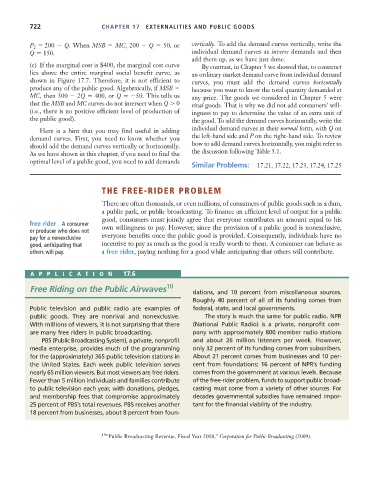Page 748 - Microeconomics, Fourth Edition
P. 748
c17ExternalitiesandPublicGoods.qxd 8/22/10 4:56 AM Page 722
722 CHAPTER 17 EXTERNALITIES AND PUBLIC GOODS
P 2 200 Q. When MSB MC, 200 Q 50, or vertically. To add the demand curves vertically, write the
Q 150. individual demand curves as inverse demands and then
add them up, as we have just done.
(c) If the marginal cost is $400, the marginal cost curve By contrast, in Chapter 5 we showed that, to construct
lies above the entire marginal social benefit curve, as an ordinary market demand curve from individual demand
shown in Figure 17.7. Therefore, it is not efficient to curves, you must add the demand curves horizontally
produce any of the public good. Algebraically, if MSB because you want to know the total quantity demanded at
MC, then 300 2Q 400, or Q 50. This tells us any price. The goods we considered in Chapter 5 were
that the MSB and MC curves do not intersect when Q 0 rival goods. That is why we did not add consumers’ will-
(i.e., there is no positive efficient level of production of ingness to pay to determine the value of an extra unit of
the public good). the good. To add the demand curves horizontally, write the
Here is a hint that you may find useful in adding individual demand curves in their normal form, with Q on
demand curves. First, you need to know whether you the left-hand side and P on the right-hand side. To review
should add the demand curves vertically or horizontally. how to add demand curves horizontally, you might refer to
As we have shown in this chapter, if you need to find the the discussion following Table 5.1.
optimal level of a public good, you need to add demands
Similar Problems: 17.21, 17.22, 17.23, 17.24, 17.25
THE FREE-RIDER PROBLEM
There are often thousands, or even millions, of consumers of public goods such as a dam,
a public park, or public broadcasting. To finance an efficient level of output for a public
good, consumers must jointly agree that everyone contributes an amount equal to his
free rider A consumer own willingness to pay. However, since the provision of a public good is nonexclusive,
or producer who does not
pay for a nonexclusive everyone benefits once the public good is provided. Consequently, individuals have no
good, anticipating that incentive to pay as much as the good is really worth to them. A consumer can behave as
others will pay. a free rider, paying nothing for a good while anticipating that others will contribute.
APPLICA TION 17.6
Free Riding on the Public Airwaves 10
dations, and 10 percent from miscellaneous sources.
Roughly 40 percent of all of its funding comes from
Public television and public radio are examples of federal, state, and local governments.
public goods. They are nonrival and nonexclusive. The story is much the same for public radio. NPR
With millions of viewers, it is not surprising that there (National Public Radio) is a private, nonprofit com-
are many free riders in public broadcasting. pany with approximately 800 member radio stations
PBS (Public Broadcasting System), a private, nonprofit and about 26 million listeners per week. However,
media enterprise, provides much of the programming only 32 percent of its funding comes from subscribers.
for the (approximately) 365 public television stations in About 21 percent comes from businesses and 10 per-
the United States. Each week public television serves cent from foundations; 16 percent of NPR’s funding
nearly 65 million viewers. But most viewers are free riders. comes from the government at various levels. Because
Fewer than 5 million individuals and families contribute of the free-rider problem, funds to support public broad-
to public television each year, with donations, pledges, casting must come from a variety of other sources. For
and membership fees that compromise approximately decades governmental subsidies have remained impor-
25 percent of PBS’s total revenues. PBS receives another tant for the financial viability of the industry.
18 percent from businesses, about 8 percent from foun-
10 “Public Broadcasting Revenue, Fiscal Year 2008,” Corporation for Public Broadcasting (2009).

